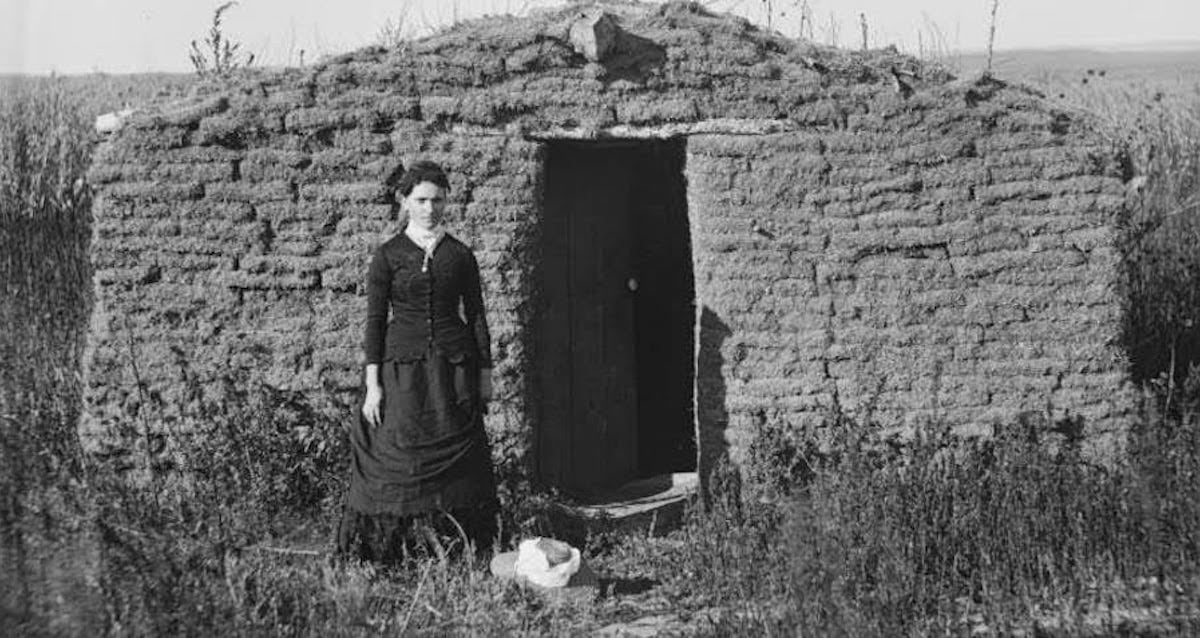
44 Photos Of Nebraska’s Earliest Settlers — And Their Grueling Lives On The Plains
In 1862, Abraham Lincoln signed the Homestead Act, promising Americans plots of frontier land if they agreed to start a farm and maintain it for at least five years. These pioneers heeded his call.

Nebraska State Historical Society A settler family poses in front of their home in Nebraska.
In 1862, the Homestead Act set the stage for the dramatic transformation of Nebraska, as thousands of settlers sought a new life on the plains.
The Homestead Act of 1862 promised 160 acres of land to Americans who were willing to build a home and farm and maintain their properties for at least five years, leading to many pioneers loading up their wagons and heading out west. Nebraska’s landscape was soon transformed, housing numerous farming communities who lived in sod houses and log cabins.
However, this westward expansion came at a cost. Nebraska’s first settlers soon realized how difficult homesteading could be, toiling on newly constructed farms and competing for limited resources. They also clashed with local Native American tribes, who had long called the region home.
Despite the perils that came with pioneer life, Nebraska’s population soon soared, allowing it to become a U.S. state and a key agricultural hub.
1 of 45
Visitors at the home of Reuben Gordon in Merna, Nebraska. Nebraska State Historical Society
2 of 45
Boys from Nebraska's State Industrial School in Kearney working in a sweet potato field. Circa 1905. Nebraska State Historical Society
3 of 45
R.G. Carr's family portrait. Circa 1887.Nebraska State Historical Society
4 of 45
The home of Isaac Newton Sims, located near Victoria Creek in Nebraska. Nebraska State Historical Society
5 of 45
The home of John Hohman in Custer County, Nebraska. Circa 1888. Nebraska State Historical Society
6 of 45
The Coleman family farm near Merna, Nebraska. Circa 1886. Nebraska State Historical Society
7 of 45
Reverend Todd at his home, located near West Union, Nebraska.Nebraska State Historical Society
8 of 45
The Custer County Republican's sod print shop in Broken Bow, Nebraska. Nebraska State Historical Society
9 of 45
The Cozad home in New Helena, Nebraska.Nebraska State Historical Society
10 of 45
The Ball family in Woods Park, Nebraska. 1886.Nebraska State Historical Society
11 of 45
James Stennard's home and farm in West Union, Nebraska. Nebraska State Historical Society
12 of 45
R.G. Carr's residence in Nebraska.Nebraska State Historical Society
13 of 45
Students pose outside of Gates School in Custer County, Nebraska. Nebraska State Historical Society
14 of 45
The Gordon family in Merna, Nebraska. Nebraska State Historical Society
15 of 45
A view of the Old Mill on Niobrara River. Nebraska State Historical Society
16 of 45
George Adams' ranch in Deer Creek. Nebraska State Historical Society
17 of 45
A snapshot of rural life in Nebraska. Library of Congress
18 of 45
The Burow family near Merna, Nebraska. Circa 1886. Nebraska State Historical Society
19 of 45
Mary Longfellow near Broken Bow, Nebraska.Nebraska State Historical Society
20 of 45
A view of Farnham Street in Omaha. Library of Congress
21 of 45
The Pierce family sitting outside the old Summerford Post Office in Nebraska. Nebraska State Historical Society
22 of 45
A picnic in Custer County, Nebraska. Nebraska State Historical Society
23 of 45
Former Judge Chas R. Mathews of New Helena, Nebraska, in front of a log building that once served as a post office. Circa 1886.Nebraska State Historical Society
24 of 45
The first jail in Broken Bow, Nebraska. Nebraska State Historical Society
25 of 45
An excursion party poses for a photo outside of Omaha. Circa 1866. Library of Congress
26 of 45
A corn picker working in Lexington, Nebraska. Circa 1905. Nebraska State Historical Society
27 of 45
The Nutter family in Buffalo County, Nebraska. Circa 1904.Nebraska State Historical Society
28 of 45
A damaged Nebraska home, after it was wrecked by a cyclone. Circa 1908. Nebraska State Historical Society
29 of 45
A teacher and her students pose for a photo in front of their schoolhouse in Buffalo County, Nebraska. Circa 1907. Nebraska State Historical Society
30 of 45
James E. McCray, a newspaper editor in Sargent, Nebraska. Circa 1886. Nebraska State Historical Society
31 of 45
The Haumont family poses in front of their home, near Broken Bow, Nebraska. Circa 1886. Library of Congress
32 of 45
Euroi Weiner, a teacher in Custer County, Nebraska. Circa 1887. Nebraska State Historical Society
33 of 45
An irrigation ditch located near Cozad, Nebraska. Circa 1904. Nebraska State Historical Society
34 of 45
Farmers stand by a steam tractor pulling a plow in Buffalo County. Nebraska State Historical Society
35 of 45
The Sumers family in Round Valley, Nebraska. Nebraska State Historical Society
36 of 45
A family in front of their home in Custer County, Nebraska. Nebraska State Historical Society
37 of 45
A couple in front of their home in Custer County, Nebraska. Circa 1886. Nebraska State Historical Society
38 of 45
The McCarty family in Custer County, Nebraska. Circa 1886. Nebraska State Historical Society
39 of 45
A photo titled "Nebraska Gothic," taken by photographer Solomon D. Butcher.Nebraska State Historical Society
40 of 45
Harvey Andrews and his family. Nebraska State Historical Society
41 of 45
Jerry Shores and his family. Nebraska State Historical Society
42 of 45
The Chrisman sisters.Nebraska State Historical Society
43 of 45
A hunter shooting from his boat. Nebraska State Historical Society
44 of 45
The Mitchell and Ketchum homestead in Custer County, Nebraska. Nebraska State Historical Society

44 Photos Of Nebraska’s Earliest Settlers — And Their Grueling Lives On The Plains
Nebraska's Early Settlers Arrive With Hope
In 1862, the Homestead Act was signed into law by Abraham Lincoln, granting American families opportunities to start new lives across millions of acres of federal land in the American West. Between 1862 and 1934, more than 1.6 million homestead applications were processed and 270 million acres of this federal land passed into the hands of individuals.
Prior to the Homestead Act, the Kansas-Nebraska Act had established the Nebraska Territory, but the territory did not see a notable influx of settlers until after the passing of the Homestead Act. The act allowed anyone over 21 who had never fought against the United States to apply for 160 acres of land in the American West. In the 1860s, settlers from across the United States and even other countries came to Nebraska in droves.

Wikimedia CommonsA 19th-century poster advertising land available in Nebraska and Iowa.
However, they were not the only ones laying claim to the land. For centuries, Native Americans had lived in the area and called it home. Indigenous tribes like the Pawnee, the Cheyenne, and the Omaha clashed with settlers and tried to stop them from taking over their land. The federal government eventually forced tribes to relocate, only increasing tensions and conflicts.
Before long, as many as 500,000 settlers made their homes in Nebraska, spurred by the creation of the Transcontinental Railroad and the aftermath of the American Civil War. But the journey westward was not always a safe one. For those who came by wagon, travel was particularly dangerous.

Public DomainA homestead certificate in Nebraska.
"The dangers were, of course, accidents. Wagons, with some frequency, ran over particularly women and children... Other kinds of accidents that occurred far more frequently than the fictional treatment of Western history would have you believe were firearm accidents. Practically all of the men were armed, but... they weren't very proficient," historian Dr. Robert Munkres explained during an interview for the show Hidden Places.
They also faced many of the same dangers they had in their former homes, but they were magnified since they felt more isolated. Despite the perils, settlers kept coming — bringing their hopes for better lives with them.
Families Build Homesteads, Sod Houses, And Farms In Rural Nebraska

Nebraska State Historical Society George Ankeney and his family in Custer County, Nebraska.
As part of the Homestead Act, settlers had to agree to take care of a plot of land for at least five years. They also needed to set up a home and farm on the plot. Only then could they officially own the land. Of course, they were also required to prove they were citizens (or working toward becoming citizens) and that they had never fought against the United States.
Considering these rules, many settlers filed a claim for land with the intention of moving their entire families. After all, many pioneers expected a higher standard of living than they had elsewhere, and having children certainly helped when cultivating and managing a large farm.
However, some settlers included groups of single men who sought out adventure and freedom. Some were Civil War veterans, who may have been disillusioned by the long-established states in the North and South.

Nebraska State Historical Society The all-male homestead of the Perry brothers near Merna, Nebraska.
Other settlers included immigrants, most commonly from Germany, Scandinavia, and Britain. Many of these groups tried to settle in regions where they could be near other immigrants from their native countries.
Some Black settlers also secured their own plots of land in Nebraska. Up to 30,000 Black Americans settled in the American West under the Homestead Act. Many of these settlers were formerly enslaved and wanted opportunities to start fresh, away from the war-torn areas of the American South.

Nebraska State Historical Society The Moses Speese family home near Westerville, Nebraska.
As required by the Homestead Act, all of these settlers built their houses on their plots and cultivated the land. Most people constructed sod homes, due to the lack of timber and other building materials in the region. Settlers with more financial resources were able to build log cabins and frame houses.
They typically farmed corn, wheat, and other grains, while growing vegetables and other crops for their personal consumption. Life was hard for these settlers, especially as they competed for limited resources, but their efforts ultimately helped transform Nebraska into the state it is today.
The Impact Of The Homestead Act On Nebraska

Nebraska State Historical Society Settlers on a farm in Custer County, Nebraska. Circa 1886.
The passing of the Homestead Act had profound impacts on Nebraska. The area's population boomed from under 30,000 in 1860 to over 450,000 by 1880. Its rapid growth allowed it to become a U.S. state in 1867 and eventually transformed it into an agricultural powerhouse.
For local Native American populations, the Homestead Act helped spell the end of peaceful relations with settlers, the federal government, and other tribes. Events like the Pawnee War, the Sioux Wars, and the Wounded Knee Massacre were the results of American westward expansion, which had been bolstered by the Homestead Act. Many Indigenous populations were eventually forced to relocate to other states, often on Indian reservations.
Today, the majority of Nebraska's population is white, with Native Americans accounting for just over 1 percent of the state's population.
Many current residents of Nebraska can trace their lineage back to the homesteaders who settled in the state during the late 1800s, and some of the most well-known Nebraskans, like Willa Cather, Mari Sandoz, and Tom Osborne, were or are descended from these early pioneers.
Some places across the state, like the Homestead National Historical Park in Beatrice, are dedicated to exploring the history of Nebraska's settlers and the impacts of westward expansion. Many of them feature historical buildings, memorable artifacts, and other powerful reminders of the families who left everything behind to make Nebraska their new home.
After reading about Nebraska's first settlers, check out 47 colorized Old West photos that bring the American frontier to life. Then, read about the Donner Party, the doomed pioneers whose journey to California ended in tragedy.








